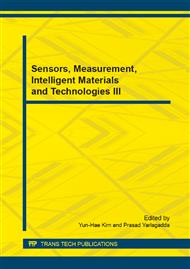[1]
P.K. Mehta. Durability of Concrete-Fifty Years of Progress. Proceeding of 2nd International Conference on Durability, Montreal Canada, 1991, pp.1-31.
DOI: 10.14359/1998
Google Scholar
[2]
Y.P. Liu, R.E. Weyers. Modeling the time to corrosion cracking in chloride contaminated reinforced concrete structures, ACI Mater. J. 95 (1998), pp.675-681.
DOI: 10.14359/410
Google Scholar
[3]
Rasheeduzzafar, Al-Saadoun S S, Al-Gahtani A S. Corrosion cracking in relation to bar diameter, cover, and concrete quality[J]. Journal of Materials in Civil Engineering, 1992(4):327-342.
DOI: 10.1061/(asce)0899-1561(1992)4:4(327)
Google Scholar
[4]
Malumbela G, Alexander M, Moyo P. Influence of corrosion crack patterns on the rate of crack widening of RC beams[J]. Construction and Building Materials, 2011(25): 2540-2553.
DOI: 10.1016/j.conbuildmat.2010.11.097
Google Scholar
[5]
David Corr a, Matteo Accardi b, Lori Graham-Brady. Digital image correlation analysis of interfacial debonding properties and fracture behavior in concrete. Engineering Fracture Mechanics, 74 (2007) 109-121.
DOI: 10.1016/j.engfracmech.2006.01.035
Google Scholar
[6]
M. Muller, E. Toussaint, J. -F. Destrebecq, M. Grédiac, Experimental and numerical study of reinforced concrete specimens strengthened with composite plates, Compos. Part A: Appl. Sci. Manuf. 35 (7-8) (2004) 885-893.
DOI: 10.1016/j.compositesa.2004.01.009
Google Scholar
[7]
M. Küntz, M. Jolin, J. Bastien, F. Perez, F. Hild, Digital image correlation analysis of crack behavior in a reinforced concrete beam during a load test, Can. J. Civil Eng. 33 (11) (2006) 1418-1425.
DOI: 10.1139/l06-106
Google Scholar
[8]
Tahreer M. Fayyada, Janet M. Leesb. Application of Digital Image Correlation to reinforced concrete fracture. Procedia Materials Science, 3 ( 2014 ) 1585 - 1590.
DOI: 10.1016/j.mspro.2014.06.256
Google Scholar
[9]
J. Helm, Digital image correlation for specimens with multiple growing cracks, Exp. Mech. 48 (6) (2008) 753-762.
DOI: 10.1007/s11340-007-9120-2
Google Scholar
[10]
D. Lecompte, J. Vantomme, H. Sol, Crack detection in a concrete beam using two different camera techniques, truct. Health Monit. 5 (1) (2006) 59-68.
DOI: 10.1177/1475921706057982
Google Scholar
[11]
Bora Gencturk, Kazi Hossain, Aadit Kapadia. Use of digital image correlation technique in full-scale testing of prestressed concrete structures. Measurement, 47 (2014) 505-515.
DOI: 10.1016/j.measurement.2013.09.018
Google Scholar


